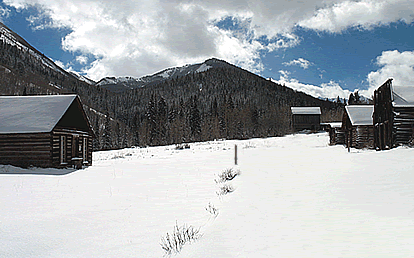| Home | About Us | Resources | Archive | Free Reports | Market Window |
Colorado's Death BlowBy
Tuesday, October 24, 2006
Ashcroft, Colorado, is a Ghost Town. Ashcroft's boom of the 1880s - and it's subsequent bust - is a remarkable story. S&A geologist Matt Badiali and I were in Aspen last week. While there, we visited the remnants of neighboring Ashcroft. Ashcroft, like most of Colorado, boomed because of silver. Ashcroft didn't exist in 1878, when the Bland-Allison Act was passed, causing a silver boom... For the previous five years, silver was "busting." You see, in 1873, the U.S. shifted to a "Gold Standard" as its system of money. Before then, gold and silver were money (in a fixed ratio to each other).
Speculators saw the opportunity right away. Miners holding the lower-priced metal (silver) would immediately go to the U.S. Mint and exchange it for the higher-valued metal (gold). President Hayes knew the Bland-Allison Act was ridiculous and vetoed it. But Congress overrode his veto. The gold-to-silver ratio at the time of passage was about 18.25 to 1 - creating an extraordinary profit opportunity. The boom was on. By 1883, Ashcroft, Colorado, had 2,000 residents, two newspapers, 20 saloons... and the mines produced an amazing 14,000 ounces of silver to the ton.
Ashcroft's story was repeated all over Colorado. Silver mining towns, such as Aspen and Telluride, appeared on the map as well. Colorado supplied 60% of America's silver production. In 1890, the Sherman Silver Purchase Act replaced the Bland-Allison Act. It was even more favorable to silver producers... The U.S. government was now requiredto buy 4.5 million ounces of silver per year - nearly the entire output of American silver mines. The opportunity for free money was even greater... Simply find silver, trade it in for gold, and get rich. The result was what you'd expect... the boom turned into a mega-boom in silver... In 1891, Aspen became the nation's largest silver producing district. By 1893, Aspen's 12,000 residents had six newspapers, four schools, three banks, electric lights, a modern hospital, two theaters, an opera house, and a brothel district. President Grover Cleveland assessed the damage to the nation's Treasury:"Between July 1, 1890 and July 15, 1893, the gold in our Treasurydecreased by more than $132 million, while the silver in the Treasuryincreased more than $147 million." 1893 was Aspen's peak for a long time... That year, President Cleveland repealed the Sherman Silver Act to prevent any further depletion of U.S. gold reserves. The price of silver fell from 83 cents to 62 cents in four days. The national economy busted immediately. Colorado entered a severe depression. (Somewhat ironically, one of the largest silver nuggets ever discovered - at 2,200 pounds - was discovered in Aspen in 1894.) Aspen's population fell to just 700 people by 1935. Telluride's population today is half of what it was back then. And Ashcroft? It's gone... Looking back, what caused the Panic of 1893? The same thing that caused the boom... Government tinkering with money. Today, the government still tinkers with money... the Federal Reserve sets the "price" of money - by setting short-term interest rates. Government tinkering with money set off a silver boom in the 1880s and a subsequent bust in 1893. More recently, government tinkering with money (artificially pushing interest rates down below 2%) set off a housing boom starting in 2001. To me, there isn't much difference in these two things - they were a result of government tinkering with money. Real-estate speculators today are getting obliterated now, just as silver speculators did after 1893. The reason is simple: It's really hard to have an artificial boom that doesn't have a subsequent bust. One thing we do here at DailyWealth is look for "free money" opportunities like these... When a government somewhere is creating a false boom, we ride it with one eye on the exit. And when the government sees the error of its ways and steps aside, we clear out quickly. The Sherman Act of 1893 was Colorado's death blow for decades. The Fed raising rates from 1% to 5.25% was the death blow for real-estate speculators. "Free money" opportunities from governments tinkering with money are some of the easiest and best profit opportunities you'll ever get... We'll continue to point them out in the pages of DailyWealth... Good investing, Steve Market NotesIS THE WORST OVER FOR FLORIDA REAL ESTATE? Longtime readers know DailyWealth sees the share price of the St. Joe Company (JOE) as one of the best real-estate barometers in the country. With 830,000 acres of Florida land on the books, JOE is the 800-pound gorilla of Sunshine State land development... and changes in real-estate sentiment are immediately reflected in its share price. JOE soared in 2004 as the real-estate boom caught fire. Investors freaked out in 2005, however, and sliced the stock in half. After bottoming around $45 a share in June, it looks like the worst is over here. Keep an eye on old man JOE. Now in the mid-50s, the rising share price is a good omen for Florida landowners. Relax and have a margarita. |
Recent Articles
|



